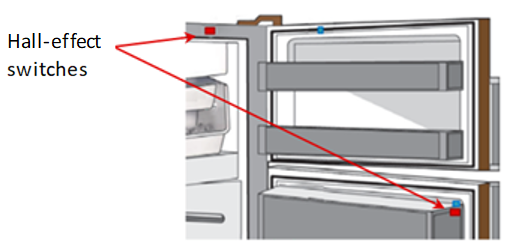Hall-effect sensors in refrigerators
As with most home appliances, over time refrigerators & freezers have evolved into electronic-intensive products. Among many other innovations such as electronic displays, Alexa-enabled WiFi, and highly efficient motor designs, refrigeration systems have many sophisticated sensors to inform the on-board MCU of the inner workings of the system. In this E2E post I will discuss three separate position sensor applications – door open/close, ice dispenser levers, and push buttons.
Door/compartment open & close detection

Mechanical and reed switches have predominantly been used in the detection of the opening & closing of the doors to control the light inside the refrigerator. These technologies have been in use for a long time but innovative companies typically make the move to better, more precise technologies first and the rest will follow. Hall-effect sensors with high sensitivity and precisely controlled hysteresis have proven to be most beneficial in this application. The table below details some of the advantages over the conventional technologies.
|
Specification |
Hall-effect switch |
Reed switch |
Mechanical switch |
System-level Benefit |
|
Magnet orientation |
Orthogonal or parallel |
Parallel |
N/A |
Hall-effect switches have options that offer greater flexibility in placing the magnet in relation to the sensor (in-plane and orthogonal). Mechanical switches do not need magnets. |
|
Current consumption during Standby |
µA to mA range (but can be in the nA range if powered down) |
Zero |
Zero |
For mains powered applications, µA to mA range is typically good enough. |
|
Polarity sensitivity |
None (omnipolar switch) |
None |
N/A |
Omnipolar switches will respond to either magnet polarity. |
|
Switch loads directly? |
Requires added circuitry |
Yes (up to single-digit amps) |
Yes |
Reed and mechanical switches essentially close the current path to the light bulb directly. |
|
Response time |
~10 µs (high-bandwidth devices) ms range (low frequency, duty-cycled devices) |
25 to 100 µs |
Immediate |
High-bandwidth Hall-effect switches are very fast. Have not tested mechanical switches, but they should be very fast as well. |
|
Life expectancy |
Effectively unlimited operations – limited by silicon life expectancy |
Up to 1 billion operations |
Limited by wear and tear of contact |
This is a major drawback of mechanical switches. |
|
Hysteresis |
Single-digit mT range |
40% - 90% variation |
None (but open/close location may vary over time to wear and tear) |
Consistent open/close location detection achieved with Hall-effect switches. |
|
Assembly |
Standard PCB assembly |
Manual board assembly |
N/A |
Reed switches experience high yield loss due to being brittle. |
|
Operating temperature |
-40°C to 125°C |
-55°C to 200°C |
Wide range |
All technologies are sufficient since room temp is essentially needed. |
|
Price |
Prices are comparable. |
All technologies should be considered for their technical merits and not pricing alone. |
||
As is summarized in the table, the main drawback to using Reed switches is the yield loss during assembly, and for a mechanical switch it is the lifetime of the product due to wear and tear. Mechanical switches are also visible in the door frame and are simply not aesthetically pleasing. In contrast, the Hall-effect switch’s main benefits are the life expectancy because of its contactless behavior and also getting consistent results in the opening & closing of the refrigerator doors, which is very important for companies that want that user experience.
Two exceptional Hall-effect switches are the DRV5032 and TMAG5123 (with in-plane sensing capability).
Ice dispenser lever and push buttons

Similar to the open & close detection of a refrigerator door, a Hall-effect switch performs the same function of detecting the presence or absence of a magnet. Consistent results can easily be achieved, and manufacturing procedures do not have to include a specific orientation of a magnet by using an omnipolar switch that responds to both north and south magnetic fields.
The LDC family of inductance to digital converters are signal conditioning ICs that measure the change in resonance of a inductive coil laid out on a PCB when a conductive target approaches or moves away from the coil. These sensors can be used to measure minute deflections in the conductive material as a button touch or as a precise linear sensor for proximity sensing.
Some of the key benefits of touch buttons, sliders or knobs implemented using inductive sensors are:
- No cutouts or holes needed: modern appearance, simpler assembly, easier to waterproof
- Multi-function buttons: Allows force detection for multi-level button functions
- Environmental protection: Inductive sensing not affected by dirt, dust, oil, water, or magnets
- Consistent performance: Requires physical pressure to activate and works with gloves on
- Extended lifetime: baseline tracking allows for recalibrating the sensor-to-metal distance in case of accidental impact to the button
Get started with TI’s inductive sensors
No matter what type of user interface or HMI you are designing, TI has the right inductive sensor for your design – the LDC3114-Q1, an automotive 4-channel inductance to digital converter for low-power proximity & touch-button sensing.
Additional Resources
- For more information on TI’s inductive sensors, check out our Inductive Sensors page
- Application note on implementing touch buttons with TI’s LDC family of inductive sensors
- Evaluate the Inductive sensing design tool to help design PCB coil sensors
- Application note on conductive target design

